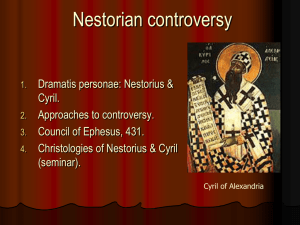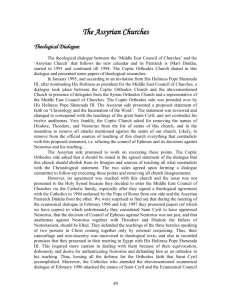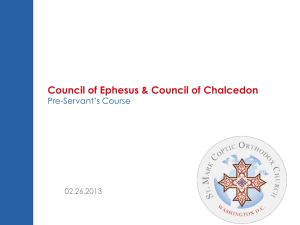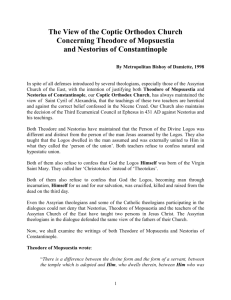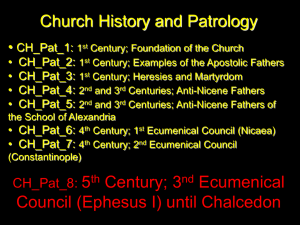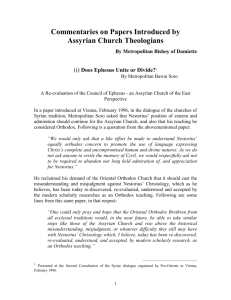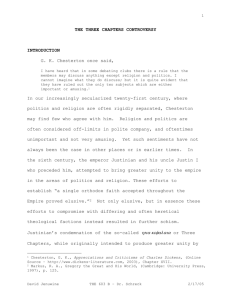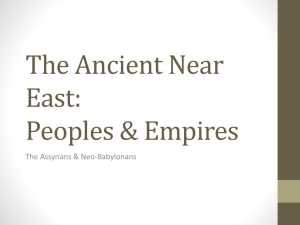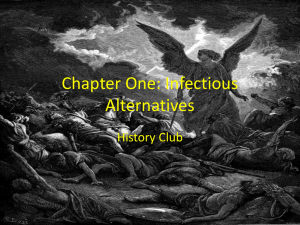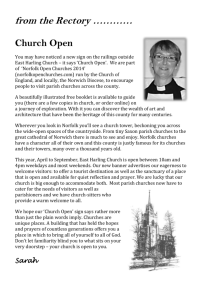The Status of the Assyrian Churc1
advertisement
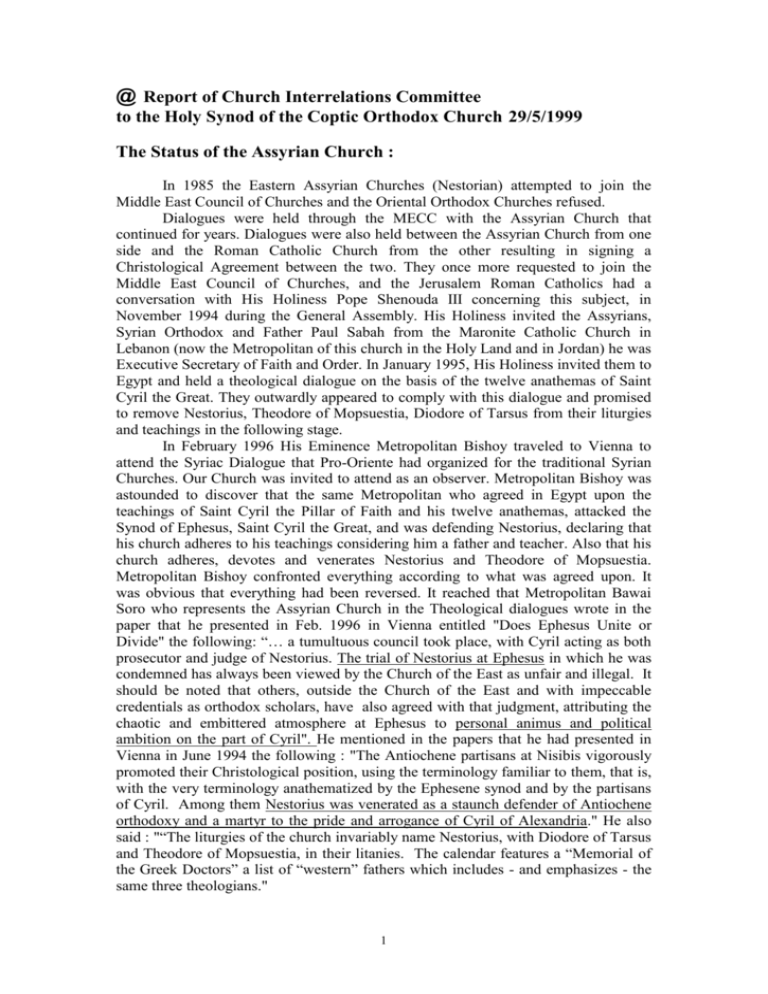
@ Report of Church Interrelations Committee to the Holy Synod of the Coptic Orthodox Church 29/5/1999 The Status of the Assyrian Church : In 1985 the Eastern Assyrian Churches (Nestorian) attempted to join the Middle East Council of Churches and the Oriental Orthodox Churches refused. Dialogues were held through the MECC with the Assyrian Church that continued for years. Dialogues were also held between the Assyrian Church from one side and the Roman Catholic Church from the other resulting in signing a Christological Agreement between the two. They once more requested to join the Middle East Council of Churches, and the Jerusalem Roman Catholics had a conversation with His Holiness Pope Shenouda III concerning this subject, in November 1994 during the General Assembly. His Holiness invited the Assyrians, Syrian Orthodox and Father Paul Sabah from the Maronite Catholic Church in Lebanon (now the Metropolitan of this church in the Holy Land and in Jordan) he was Executive Secretary of Faith and Order. In January 1995, His Holiness invited them to Egypt and held a theological dialogue on the basis of the twelve anathemas of Saint Cyril the Great. They outwardly appeared to comply with this dialogue and promised to remove Nestorius, Theodore of Mopsuestia, Diodore of Tarsus from their liturgies and teachings in the following stage. In February 1996 His Eminence Metropolitan Bishoy traveled to Vienna to attend the Syriac Dialogue that Pro-Oriente had organized for the traditional Syrian Churches. Our Church was invited to attend as an observer. Metropolitan Bishoy was astounded to discover that the same Metropolitan who agreed in Egypt upon the teachings of Saint Cyril the Pillar of Faith and his twelve anathemas, attacked the Synod of Ephesus, Saint Cyril the Great, and was defending Nestorius, declaring that his church adheres to his teachings considering him a father and teacher. Also that his church adheres, devotes and venerates Nestorius and Theodore of Mopsuestia. Metropolitan Bishoy confronted everything according to what was agreed upon. It was obvious that everything had been reversed. It reached that Metropolitan Bawai Soro who represents the Assyrian Church in the Theological dialogues wrote in the paper that he presented in Feb. 1996 in Vienna entitled "Does Ephesus Unite or Divide" the following: “… a tumultuous council took place, with Cyril acting as both prosecutor and judge of Nestorius. The trial of Nestorius at Ephesus in which he was condemned has always been viewed by the Church of the East as unfair and illegal. It should be noted that others, outside the Church of the East and with impeccable credentials as orthodox scholars, have also agreed with that judgment, attributing the chaotic and embittered atmosphere at Ephesus to personal animus and political ambition on the part of Cyril". He mentioned in the papers that he had presented in Vienna in June 1994 the following : "The Antiochene partisans at Nisibis vigorously promoted their Christological position, using the terminology familiar to them, that is, with the very terminology anathematized by the Ephesene synod and by the partisans of Cyril. Among them Nestorius was venerated as a staunch defender of Antiochene orthodoxy and a martyr to the pride and arrogance of Cyril of Alexandria." He also said : "“The liturgies of the church invariably name Nestorius, with Diodore of Tarsus and Theodore of Mopsuestia, in their litanies. The calendar features a “Memorial of the Greek Doctors” a list of “western” fathers which includes - and emphasizes - the same three theologians." 1 Regarding the establishment of the Assyrian Church and its nomination, Metropolitan Bawai Soro in his paper entitled Summary of the Christological Debate, presented in Vienna in February 1996 wrote: "Although the Assyrians state that Nestorius is not their founder and therefore refuse to be called Nestorians, the general trend is that Nestorius, though Greek, is very much their father." It is obvious that the nomination was not fundamental, but the teaching and the mental association is the most important. So the Assyrians are Nestorians in their doctrines and they consider Nestorius as one of the most important fathers and teachers of their Church. They hold to this Christological teaching that the Synod of Ephesus anthematized. Clearly, all which was previously mentioned concerning the Christological Agreements that the Assyrians signed with the Church of Rome, or what they were ready to sign with our Church is a camouflage. Subsequently, they announced retaining the teachings of Nestorius that the Synod of Ephesus anathematized, rejected the Synod of Ephesus and its decisions, and hold to the teachings of Nestorius as a Saint and teacher in their Church. They always commemorate him in their prayers and make festivals for him. In their doctrine they proclaim that there are two hypostaseis in Christ after the union, that the union is between persons i.e. between persons in Christ, which is called prosopic union, or external union. They refuse the prosopic union and the hypostatic union and hold to the expression Christotokos (Mother of Christ) instead of Theotokos (Mother of God). As long as they refuse to anathematize Nestorius, Theodore of Mopsuestia and Diodore of Tarsus and reject the decision of the Third Ecumenical Council of Ephesus, they are to be considered Nestorians trying to hide behind deceiving papers. This does not improve or delay their practice, liturgical life and didactic life in their Church. Concerning the Middle East Council of Churches, His Holiness Pope Shenouda III headed the session of the Executive Committee of the Council in October 1998. It was resolved to reject the Assyrians joining the Council, since they are not in communal unity with any of the four families in the Council. His Holiness also explained during the meeting of the Executive Committee held before the Seventh General Assembly in April 1999, the reasons for not accepting Nestorians to join the Middle East Council of Churches. The three Oriental Orthodox Churches in the Middle East took one stand towards this case and declared anathematizing Nestorius and his followers in the meeting of the three Patriarchs both in Egypt March 1998, and in Syria in February 1999. 2
